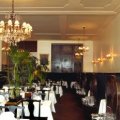The family restaurant, the dining room, the canteen, the cultural venue..
The first ninety years of Kosmos testify to the durability of a company faithful to its own style. However, despite the restaurant's apparent timelessness, its ambience, its clientele and its food and drink preferences, Kosmos has changed over the course of its history.
When, in 1924, Yrjö Teodor Lindfors founded Kosmos dining rooms in what was then Vladimirinkatu Street, prohibition reigned in Finland. This modern, upscale yet moderately priced restaurant found favor with university students in particular.
The easing of the Great Depression ushered in a new era in which Vladimirinkatu was replaced by the more patriotic Kalevankatu, the Swedish name Lindfors was fashionably translated into Finnish Hepolampi and 1932 brought the repeal of prohibition. Growing prosperity attracted new customers: lawyers, artists, civil servants, businessmen - and even the occasional businesswoman.
Mrs. Aino Hepolampi took over the management of the company. The winter war (1939-40) put an end to coffee, then beer, and frugal meals served in exchange for coupons were rationed to the gram. With the end of Finland's so-called Continuation War (1941-44) already in sight, business came to a halt when Kosmos was requisitioned and rented out for use as a dining hall by the German army.
After the war, lunches were supplemented by generous quantities of schnapps, and the punches and cognacs that finished meals were followed by the typical cocktails of the period.
As part of a state-led moralistic campaign, the alcohol monopoly restricted alcohol consumption and availability in restaurants, and Kosmos was severely reprimanded for its disproportionate sales of strong spirits.
The menu's staples - veal escalope à la Oscar, Robert's pork chop and fried salmon with tartar sauce - were gradually joined by international newcomers such as paella, chop suey and cannelloni.
Today, our cuisine seeks to highlight a culinary culture most characteristic of our capital, creating a "Helsinki cuisine" based on longstanding Russian, French and Swedish influences combined with updated Finnish culinary traditions and indigenous ingredients. From Baltic herring to whitefish roe blinis, sweetbread salad with reindeer and spruce shoot sauce, these are delicacies that also appeal to international tastes.
By the 1950s, the clientele included artists and journalists associated with nearby newspaper offices. In the 1960s, Kosmos was invaded by writers and left-wing radicals. Kosmos became a cultural meeting place. The "best" writers drank cognac, while everyone else turned to wine.
It was at this time that the first objets d'art for the dining room were acquired. The works of art our guests can enjoy are by Juhani Harri, Alvar Gullichsen, Martti Aiha, Olli Pajulahti and Sirkku Ala-Harja.
Table linen, skirting boards, chandelier shades and planters were added at a later date, but the interior of the dining room has essentially retained its original appearance, created by architecture student Arvo Aalto, furniture designer Einari Kyöstilä and Eino Räsänen, who sculpted the Hellenic motifs on the stand panels. In 2001, the entrance was renovated by Stefan Lindfors and discreet modifications to the dining room were overseen by Kaisa Blomstedt.
In these crosscurrents of past and present, of respect for preservation and renewal, perhaps what has endured best is Yrjö Hepolampi's original and simple business idea: now in our fourth generation as a family business, we continue to serve with impartiality. and are the pride of rich and poor, civil elite and ordinary customers alike.









